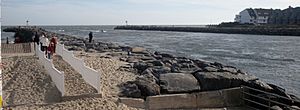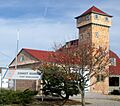Manasquan Inlet facts for kids

The Manasquan Inlet is a special waterway that connects the big Atlantic Ocean to the Manasquan River. It also acts as a natural border between Ocean County and Monmouth County in New Jersey. From here, boats can travel to Bay Head Harbor and the Barnegat Bay by using the Point Pleasant Canal.
The inlet you see today was dug in the 1920s. Before that, the original inlet was located near Stockton Lake. This inlet is also the very northern end of the Intracoastal Waterway, which is like a highway for boats along the coast.
The Manasquan Inlet is also home to a US Coast Guard station. This station helps keep everyone safe on the water.
Contents
History of the Manasquan Inlet
The Manasquan Inlet has an interesting past, especially during the American Revolutionary War.
Revolutionary War Attacks
On April 5, 1778, about 135 British soldiers and their supporters came into the inlet. Their goal was to attack and destroy the Union salt works. Salt works were places where salt was made by drying out seawater. Salt was very important back then for preserving food.
The attackers burned down the salt works and broke the large kettles used to make salt. They also searched nearby homes before leaving. They then headed north to attack other salt works.
The Union salt works were repaired, but they were attacked again on April 21, 1780. This time, a group of soldiers sailed south from Sandy Hook to raid the salt works.
The Inlet's Changing Location
The Manasquan Inlet's location has changed over time. In 1868, it was located several thousand yards north of where it is today. Back then, it was closer to the old Manasquan Coast Guard Station, near Stockton Lake.
Historically, the Manasquan Inlet was always shallow. This made it hard for large boats to pass through.
The Inlet Closes and Reopens
When the Point Pleasant Canal was dug in 1926, something unexpected happened. The water from the Manasquan River started flowing quickly through this new man-made canal. This changed the natural flow of the river and caused the inlet to completely fill with sand for several years!
The inlet was so completely closed that people could actually walk from Manasquan to Point Pleasant Beach on dry ground.
From 1926 to 1931, many people tried to reopen the inlet. The National Guard and local firefighters even used high-pressure water to try and wash away a narrow channel through the sand. However, these efforts did not work, and the inlet stayed closed.
In 1930, serious work began to reopen the inlet. The Army Corps of Engineers started building temporary piers and then permanent jetties. Jetties are long structures built into the water to protect the coastline and keep channels open. The rocks used for these jetties came from the excavation of the Second Avenue Subway in Manhattan.
This big project cost $600,000, with money coming from local, state, and federal governments. The Manasquan Inlet was officially reopened on August 29, 1931. There was a big parade of boats, and the Governor of New Jersey, Morgan F. Larson, even attended the celebration!
Surfing at Manasquan Inlet
The Manasquan Inlet is famous for being one of the best places to surf on the East Coast of the United States.
Why Surfers Love It
Its popularity comes from the inlet itself. The way the inlet is shaped helps to direct and often make the waves bigger as they come in from the ocean. This creates a fantastic "right break," which is a type of wave that surfers love.
Surfing Competitions
Many surfing competitions are held at the Manasquan Inlet throughout the year. One of the most popular events is the Manasquan Classic Longboard Contest. This competition happens every September.
In 2011, the contest celebrated its 19th year. They held a special "paddle out" on September 11th to remember the attacks on the World Trade Center ten years earlier.
Famous Surfers Visit
In August 2009, a big hurricane named Hurricane Bill sent huge waves to the shores of Manasquan. These amazing waves attracted many professional surfers to the Manasquan Inlet. Some of the well-known surfers who came to ride the waves included Andy Irons, Pete Mendia, Sam Hammer, and Mike Gleason.
Images for kids



